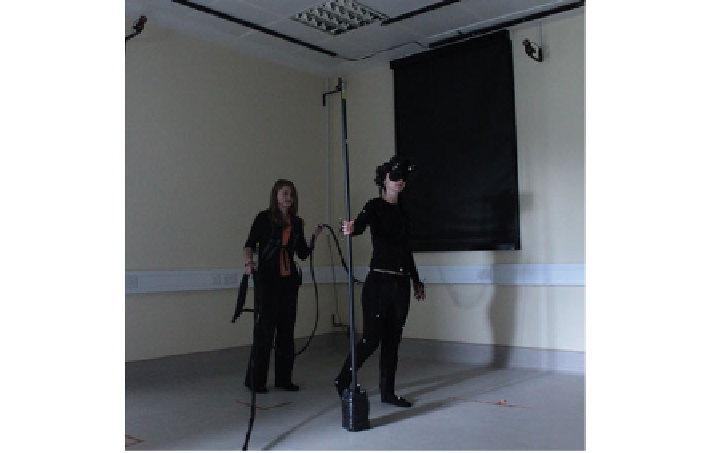Biomedical Engineering Reference
In-Depth Information
Fig. 7.12
A user wearing a motion capture suit within an OptiTrak installation. The user is taking
part an experiment involving a simulation of a train. Courtesy of Angus Antley, University College
London
of rigid bodies can be quite accurate and stable, so this approach is used for head
tracking in order to ensure stability of the view. In some situations it is useful to
have a full motion-capture setup where the body of the user is captured to monitor
her limbs movements and potentially create a virtual representation of the user in
real-time. In this case, a skeleton can be created and fit to the positions of the marker
points. This tends to be slightly less accurate and stable.
A specific technology that is currently quite commonly used in similar situations
is the InterSense IS900 (Fig.
7.13
). This combines ultrasonic technology with inertial
measurements. The IS900 is a common tracker in CAVE™-like installations or other
larger spaces, or in situations otherwise not conducive to magnetic tracking.
Other common “cheap” position tracking technologies are marker-based and
image-based. The seminal system is the ARToolkit system [
14
], where the posi-
tion of a printed marker relative to a camera is derived. On its own, the tracking of a
single marker is too noisy to, say, mount a camera on a head to track the head for a
HMD display. The marker must be visible for a start. However with sets of markers
and calibration of the locations of markers, a versatile position tracker can be built.
This type of technology has been commercialized. An example is the InterSense
IS1200 system. A novel system using virtual markers in a CAVE™-like environ-
ment was proposed by [
13
]. They proposed placing virtual markers behind the head
of the user of the display. These could be used to accurately update the head position,
which in turn could be used to move the markers out of the vision of user.

